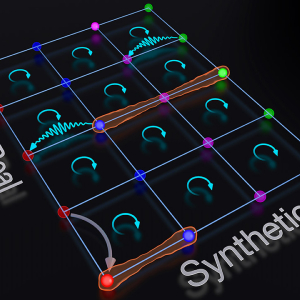Research Highlights
Atomic & Molecular Physics | Laser Physics | Precision Measurement
JILA Collaboration Makes Cavity Quantum Electrodynamics into a Team Sport
Published:
PI: Ana Maria Rey | PI: James Thompson
Laser Physics | Quantum Information Science & Technology
Smoother Ticking Through Topology
Published:
PI: Ana Maria Rey | PI: James Thompson | PI: Jun Ye
Laser Physics | Precision Measurement | Quantum Information Science & Technology
The Pursuit of Perfect Timekeeping
Published:
PI: Jun Ye | PI: Ana Maria Rey
Laser Physics | Precision Measurement | Quantum Information Science & Technology
Where Motion Meets Spin: A Quantum Leap in Simulating Magnetism
Published:
PI: Jun Ye | PI: Ana Maria Rey | PI: John Bohn
Atomic & Molecular Physics | Quantum Information Science & Technology
Quantum Teleportation Gets an Ionic 2D Upgrade
Published:
PI: Ana Maria Rey
Laser Physics | Quantum Information Science & Technology
Sneaky Clocks: Uncovering Einstein’s Relativity in an Interacting Atomic Playground
Published:
PI: Ana Maria Rey | PI: Jun Ye
Precision Measurement | Quantum Information Science & Technology
Making a Leap by Using “Another State to Entangle”
Published:
PI: Ana Maria Rey | PI: James Thompson
Precision Measurement | Quantum Information Science & Technology
No Cavity, No Party: Free-Space Atoms Give Superradiant Transition a Pass
Published:
PI: Ana Maria Rey
Precision Measurement | Quantum Information Science & Technology
To Measure or Not to Measure, but Dynamically Evolve—That is the Question
Published:
PI: Ana Maria Rey | PI: James Thompson
Quantum Information Science & Technology
A 3D Ion Magnet, the New Experimental Frontier for Quantum Information Processing
Published:
PI: Ana Maria Rey
Precision Measurement | Quantum Information Science & Technology
Twisting and Binding Matter Waves with Photons in a Cavity
Published:
PI: Ana Maria Rey | PI: James Thompson | PI: Murray Holland
Precision Measurement | Quantum Information Science & Technology
Squeezing in the Dark of a Superradiant Roller Coaster
Published:
PI: Ana Maria Rey
Precision Measurement | Quantum Information Science & Technology
B-C-S—Easy as I, II, III: Unveiling Dynamic Superconductivity
Published:
PI: Ana Maria Rey | PI: James Thompson
Precision Measurement | Quantum Information Science & Technology
New Spin-Squeezing Techniques Let Atoms Work Together for Better Quantum Measurements
Published:
PI: Adam Kaufman | PI: Ana Maria Rey
Precision Measurement | Quantum Information Science & Technology
Entangled Pairs Get Sensitive Very Fast
Published:
PI: Ana Maria Rey | PI: James Thompson
Precision Measurement | Quantum Information Science & Technology
Using Ion Crystals to Simulate Superconductors
Published:
PI: Ana Maria Rey
Precision Measurement | Quantum Information Science & Technology
A Quantum Video Reel
Published:
PI: Cindy Regal | PI: Ana Maria Rey
Atomic & Molecular Physics | Quantum Information Science & Technology
Atoms do the Twist
Published:
PI: Ana Maria Rey
Precision Measurement | Quantum Information Science & Technology
A Magic Balance in Optical Lattice Clocks
Published:
PI: Ana Maria Rey | PI: Jun Ye
Quantum Information Science & Technology
Clearing Quantum Traffic Jams under the SU(n) of Symmetric Collisions
Published:
PI: Ana Maria Rey























